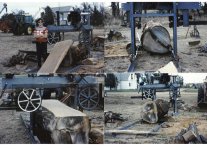tuolumne
Gold Member
I have posted a similar thead in a DIY bandmill forum, but TBN sees way more traffic and I have always valued the input from here very much.
I am looking to build a sawmill to turn my pasture/field clearing project into saleable (and usable for me) product to help support our homesteading efforts. I do not intend to have this be a portable sawmill at this point. I am looking to build something that looks like a Linn Lumber cutter head as on many home-built mills, but fixed rather than moving. Help me explore why are others not using this power option on small mills. This will be a horizontal bandsaw mill, not a circular saw.
For me, it seems simplest to power a stationary cutter head from my tractor PTO and thereby avoid another engine to maintain. Also, I have 37 HP available and I think I could maintain acceptable torque at lower RPMs to save on fuel and noise. Tractor hydraulics would also then be availabe for future carriage drive motor, hydraulic turner/clamping system etc. I could have a gearbox in the carriage that moves up and down within normal limits of 3PH movement for the drive shaft. Why haven't I seen others doing this? Please add to my pros and cons (or refute them!) I will edit this post to keep all pros and cons current at the top of the page. You'll notice that most of my cons have an argument noted afterward, so you can see that I am personally biased.
Pro:
-Already have an engine with lots of HP and hydraulic function.
-Stationary cutter=stationary sawyer.
-Log weight on moving carriage is enough to preven vibrations/fixed cutter head wold be more stable. Likewise, band carriage is fixed to rails.
-Log load and board stacking on same side of machine
-Variable band speed using engine rpm depending on log, moisture etc.
-Saw under shed with engine outside for fumes
-Sawdust all in one pile
Con:
-Longer rail bed to accomodate moving carriage for logs (more steel): seems simple enought to build, It would need to be about 22' long for a 9' carriage to handle 13' logs with a bit of cantilever and works in CAD so far
-Sawdust will be headed toward tractor with drive wheel on that side; it could be directed a bit I imagine; better than scattered along the whole rail on the operator side like most portable mills.
-Band always running? I could rig a switch to the operator area from the tractors' "operator presence" to kill the PTO in an emergency.
-Tractor must be disconnected to load logs; perhaps 8 at a time on a loading rail. I need a break from sawing anyway.
Thanks!
I am looking to build a sawmill to turn my pasture/field clearing project into saleable (and usable for me) product to help support our homesteading efforts. I do not intend to have this be a portable sawmill at this point. I am looking to build something that looks like a Linn Lumber cutter head as on many home-built mills, but fixed rather than moving. Help me explore why are others not using this power option on small mills. This will be a horizontal bandsaw mill, not a circular saw.
For me, it seems simplest to power a stationary cutter head from my tractor PTO and thereby avoid another engine to maintain. Also, I have 37 HP available and I think I could maintain acceptable torque at lower RPMs to save on fuel and noise. Tractor hydraulics would also then be availabe for future carriage drive motor, hydraulic turner/clamping system etc. I could have a gearbox in the carriage that moves up and down within normal limits of 3PH movement for the drive shaft. Why haven't I seen others doing this? Please add to my pros and cons (or refute them!) I will edit this post to keep all pros and cons current at the top of the page. You'll notice that most of my cons have an argument noted afterward, so you can see that I am personally biased.
Pro:
-Already have an engine with lots of HP and hydraulic function.
-Stationary cutter=stationary sawyer.
-Log weight on moving carriage is enough to preven vibrations/fixed cutter head wold be more stable. Likewise, band carriage is fixed to rails.
-Log load and board stacking on same side of machine
-Variable band speed using engine rpm depending on log, moisture etc.
-Saw under shed with engine outside for fumes
-Sawdust all in one pile
Con:
-Longer rail bed to accomodate moving carriage for logs (more steel): seems simple enought to build, It would need to be about 22' long for a 9' carriage to handle 13' logs with a bit of cantilever and works in CAD so far
-Sawdust will be headed toward tractor with drive wheel on that side; it could be directed a bit I imagine; better than scattered along the whole rail on the operator side like most portable mills.
-Band always running? I could rig a switch to the operator area from the tractors' "operator presence" to kill the PTO in an emergency.
-Tractor must be disconnected to load logs; perhaps 8 at a time on a loading rail. I need a break from sawing anyway.
Thanks!
Last edited:
